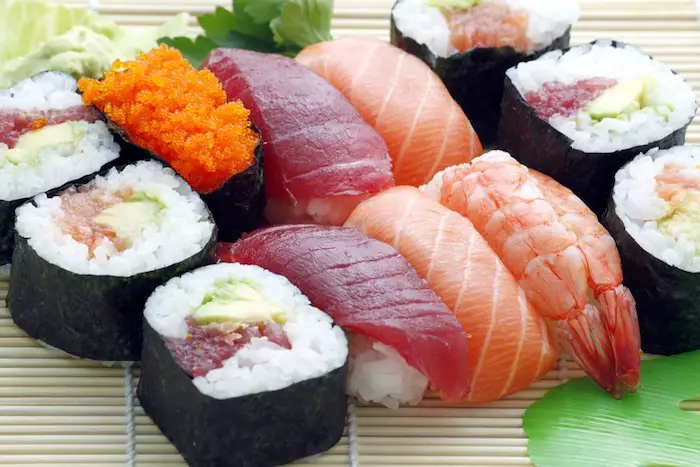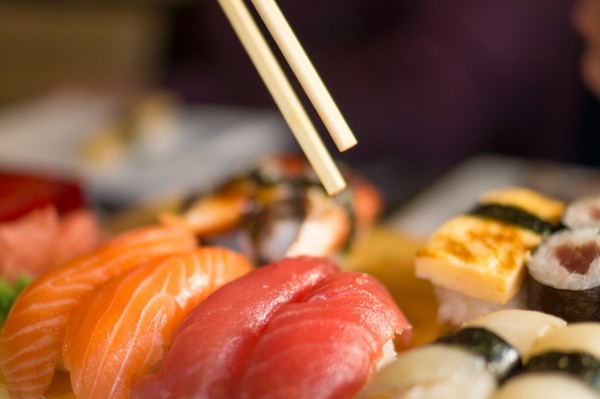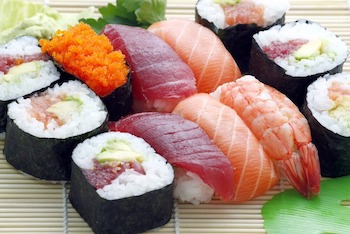We are reader supported. When you purchase through links on our site, we may earn an affiliate commission. Also, as an Amazon affiliate, we earn from qualifying purchases.

My stay in Japan and rendezvous with authentic Japanese cuisine helped me acquire a liking for sushi prepared with raw fish. Since then, I have eaten different types of sushi in various restaurants and sushi bars across the world. Some were incredibly good, others not so fresh!
That made me look for ways on how to tell if sushi is fresh. I discovered that the key things you need to look for when eating sushi are the smell, the look, the taste, and the feel. Raw sushi-grade fish does not smell fishy. The Nori wrap should feel crisp, not mushy. Your sushi should look bright, luscious, and inviting.
Although sushi contains several other ingredients such as vinegared sushi rice, and optional veggies and fruits such as cucumbers, avocados, and bell peppers, it is the raw fish in traditional sushi that makes or breaks the ‘freshness’ quotient of the dish.
Sushi in western countries has a slightly different taste and appearance to appeal the non-Japanese customers. However, the parameters for freshness remain the same. This dish tastes best when servedfresh, so look out for the signs that might ring a warning bell!
Contents
How To Tell If Sushi Is Fresh By Smell
Sushi has gained popularity in different parts of the world and it is often a quick grab-and-go meal option for busy bees. From teriyaki and tempura to nigiri, sashimi and a plethora of other complex sushi dishes, there are so many options to choose from. However, for a dish that primarily composes of seasoned rice and raw fish, it is important to ensure that you eat fresh.
Smell is an important indicator to tell if the sushi is fresh or not. The ‘smell’ usually emancipates from the quality of fish. If the sushi has high-quality fish that has been flash frozen and properly stored from the moment it is caught in the net to your plate, it will not smell fishy.
If your sushi smells a lot like sea or fishy then the fish used is probably not good quality. A popular sushi chef Hidekazu Tojo once said that a good sushi restaurant should not smell like fish but like cucumber or watermelon.
What Does The Look Say About The Freshness Of Sushi
While the smell is the first and most important factor, the second tell-a-tale sign is that of the appearance or looks. The way your sushi looks tells a lot about its freshness level. So, take a good look at it to ensure that the flesh of the fish looks bright, shiny, and translucent.

Fresh fish has a radiance of its own, which differentiates it from old or stale fish. While most of the sushi restaurants and bars use frozen fish, you can still tell the ‘preserved freshness’ by looking at it. Frozen fish retains a bright color that looks uniform without any blotchy patches or discoloration.
If the fish has a milky slime or looks dull then it’s a major sign that your sushi is not fresh. Sushi rice must be firm and fresh. It should not taste too sweet or too sour but just a perfect balance of flavor. The Nori seaweed on the outside should be crisp when you bite on it. If the sushi sits for too long, the sushi rice leaves moisture, which makes the seaweed wrap mushier.
If your sushi has tuna then please remember that looks can be deceiving. In the food industry, it is a common practice togas tuna using carbon monoxide to change the appearance and make it look pink. So, if tuna looks pink, it may not necessarily be fresh. Look at the edges to see if there are any brown spots. If the tuna looks like it’s turning brown along the edges, get a vegetable sushi roll instead.
How Can You Feel And Tell If Sushi Is Fresh
The looks may sometimes deceive you, but the ‘feel’ when you touch the sushi is always reliable. Touch the flesh of the fish used in the sushi to ensure that it is firm enough. When you press the flesh using your finger, it should not leave an indentation. If the finger mark stays, the fish is not fresh so always do this small finger-test before consuming sushi.
Another way to feel is by checking the inside of the packaging to see if there are signs of condensation. Touch the package to see if it feels mushy or condensed. Unless you are eating fresh sushi at a sushi bar or making one at home, the quick meals should have a clean packaging that indicates the product has been stored on a constant temperature to lock the freshness.
What Does The Taste Say About Freshness Of Sushi

Well, let me tell that you if the sushi fails on the above three parameters then there’s no chance that you should be tasting it. If a product does not smell, look or feel right, you must stay away from it at all cost – unless you are keen on inviting food poisoning!
Let’s assume that the sushi gets full marks or close to full marks in all above points then the final check would be the ‘taste’. Fresh raw salmon has a soft texture that melts into your mouth as you bite. It goes well with sauces and marinades. Tuna has a slightly meaty taste but feels light and clean.
When buying a prepared meal, don’t be afraid to ask about the quality of sushi. The more popular and better sushi shop, chances are your food was prepared more recently. Don’t be afraid to ask questions to the staff regarding the date and time when the meal was prepared.
It is better to always buy sushi from a place where it is made fresh and not pre-prepared off-site. Ask the store manager if they have a sushi chef because if they have one then your meals are made fresh every day! Some packages will contain stickers that tell when the sushi was packed so you know that you are eating fresh food.
If you are ordering salmon sushi, you must ensure that the fish has been frozen and handled correctly to kill parasites. Ask the staff details on how the fish was handled and the way it is prepared. If you are feeling unsure, avoid salmon altogether and choose salt water fish that poses fewer health risks.
7 Ways To Tell Whether A Sushi Restaurant Is Good Or Bad
In Japan, I never had to think before buying sushi because most of the restaurants serve them fresh. The reason being popularity and demand which makes sushi sell like hot cakes. When eating sushi in a restaurant outside of Japan, you need to be careful about your choices. Here are 7 ways to tell whether a sushi restaurant is good or bad.
1. Look for the right balance of ingredients
Sushi primarily includes sushi rice, seaweed, fish, and/or veggies. Whether you order a fish sushi or a vegetable sushi, there should be a good balance between sushi rice and fillings. It is understandable that if the proportions are off, the sushi will not taste as expected.
Unless there is a proper balance, one ingredient can become overwhelming and spoil the taste. The perfect amount of rice, the correct size of fish and properly cut veggies are what give you a mouthful flavor when you bite into a delicious sushi roll.
2. Always buy from dedicated sushi bars and restaurants
If you are trying sushi for the first time, you may not know what to order or where to buy from. To be on the safe side, I would suggest that you buy sushi from a dedicated restaurant or sushi bar. There are two different things – not knowing what to eat in a sushi bar, and going to a restaurant that serves sushi, fried rice, lasagna, noodle soup, and so on.
I suggest that you avoid the second option. If a restaurant does not sell sushi exclusively, chances are it’s not paying enough attention to the quality. And trust me, I can tell by experience that ifsushi is not given proper attention, it does not take long for it to turngross.
3. Does the sushi restaurant smell fishy?
As a sushi newbie, you may think sushi contains raw fish so it’s obvious the place will smell fishy. You are wrong!Sushi contains fish for sure, but fresh fish does not have a fishy smell. If the restaurant you walk into, smells a lot like fish then it is probably because they don’t clean properly.
Go by what the world famous sushi chef said, a good sushi restaurant should smell of cucumbers and watermelons. I would recommend that you look for dedicated sushi bars in your area because they usually have chefs that prepare sushi right in front of you. It’s not just a treat for the taste buds but also for your eyes.
4. Sushi is best served in small sizes
Sushi is meant to be light and eatable in one single bite. You should not be filling yourself up with sushi. If you go to a restaurant and they serve you sushi that is crammed with fillings of all kinds, chances are they are not legit.
With so many fillings clamoring for attention, it is difficult for you to relish the taste. The traditional and dedicated sushi places will focus on one flavor and make it outstanding! You can choose from the different variations ranging from salmon sushi, cucumber sushi, avocado sushi, and so on.
5. Unorthodox fillings should raise a red flag
If your sushi contains unorthodox fillings, chances are the restaurant is trying too hard. Sushi is meant to be simple and light. It should not be overly ornamental or too stuffed with a
If anything raises a red flag, you should better avoid that place. It is better to make your own homemade sushi at home than pay and not feel satisfied at a sushi restaurant.
6. Stay away from all-you-can-eat restaurants
Sushi is supposed to be of high quality, made from carefully selected sushi-grade fish. They are prepared by a dedicated sushi chef. Think reasonably! You can’t get high-quality all-you-can-eat sushi for just $12. If a restaurant serves unlimited sushi, it is a clear sign that the quality is compromised for quantity.
When sushi is rolled out quickly in buffet style, it is not made with care! It only results in lower quality ingredients, but the fish may also be bad and that’s probably why they wish to get rid of the stock quickly. So, stay away from such tempting offers unless you wish to invite stomach ache.
7. Check online reviews before going to a sushi restaurant
This goes without saying but still is an important piece of advice. When you are planning to eat sushi for dinner, check online reviews on Yelp or similar sites to ensure that the place serves good and fresh sushi. Sometimes, glitzy restaurants that appear incredible from the outside fall short on food quality while a small sushi bar can turn out to be a winner!
Don’t spoil a dinner date or anniversary! Even if it’s just you wanting to relish mouthwatering sushi, checking online reviews can save you time, energy and money! Also, remember that sushi restaurants selling quality products usually stay closed on Monday because itis hard to get fresh fish.
Related Questions
What is sushi-grade fish?
If a package says sushi-grade fish, it means it is the highest quality fish stored as per the FDA regulations to keep the flesh fresh and parasites free. Tuna is inspected and then labeled sushi-grade by the wholesalers. Salmon is flash frozen immediately after it is pulled out of the water to kill parasites and bacteria. It also helps in preserving the texture and freshness.
For More: Do You Need Sushi Grade Fish To Make Sushi?
Is fresh always the best?
Some varieties of fish are aged and marinated before they are used in making sushi. Saba or mackerel is treated with salt for two hours then soaked and marinated in vinegar to kill parasites and preserve the flavor. Tuna is often aged for 3-4 days in sushi shops to make it taste best in sushi.
Is sushi quality determined by the freshness of fish alone?
If you are have eaten traditional sushi, you will know that the quality of sushi rice (Shari) is as important as Netaor fish. Some restaurants emphasize a lot on the fish quality and don’t pay attention to what sushi connoisseurs consider as the real thing – the rice. The art of preparing the delicately flavored S
Can sushi be eaten without fish?
Yes, if you are a vegetarian you may substitute fish with vegetable and fruit options. Some of the commonly used veggies for sushi are cucumber, avocados, bell papers, mangoes, and so on.
The Final Words
Sushi is a delicate and traditional dish where ‘freshness’ plays a major role. As the primary dish contains raw fish of different varieties, they taste best and are healthy only when eaten fresh. However, fresh does not indicate straight out of the fish. Some varieties are flash frozen, while others may be marinated to keep the freshness intact and make it good to be eaten raw.
When choosing a sushi restaurant, always remember to check online reviews and make the best use of your senses (touch, smell, sight, and taste) to tell if the sushi is fresh. If you live in a place where you don’t have a good sushi restaurant close by, I would recommend that you make sushi at home. The recipe is simple and it’s fun to make. Try it once and I am sure you will want to do it frequently!


Comments
Pingback: Can You Freeze Sushi? - Easy Homemade Sushi
Pingback: Can You Make Sushi From Frozen Salmon? - Easy Homemade Sushi
Pingback: Nigiri sushi: all you need to know - Easy Homemade Sushi